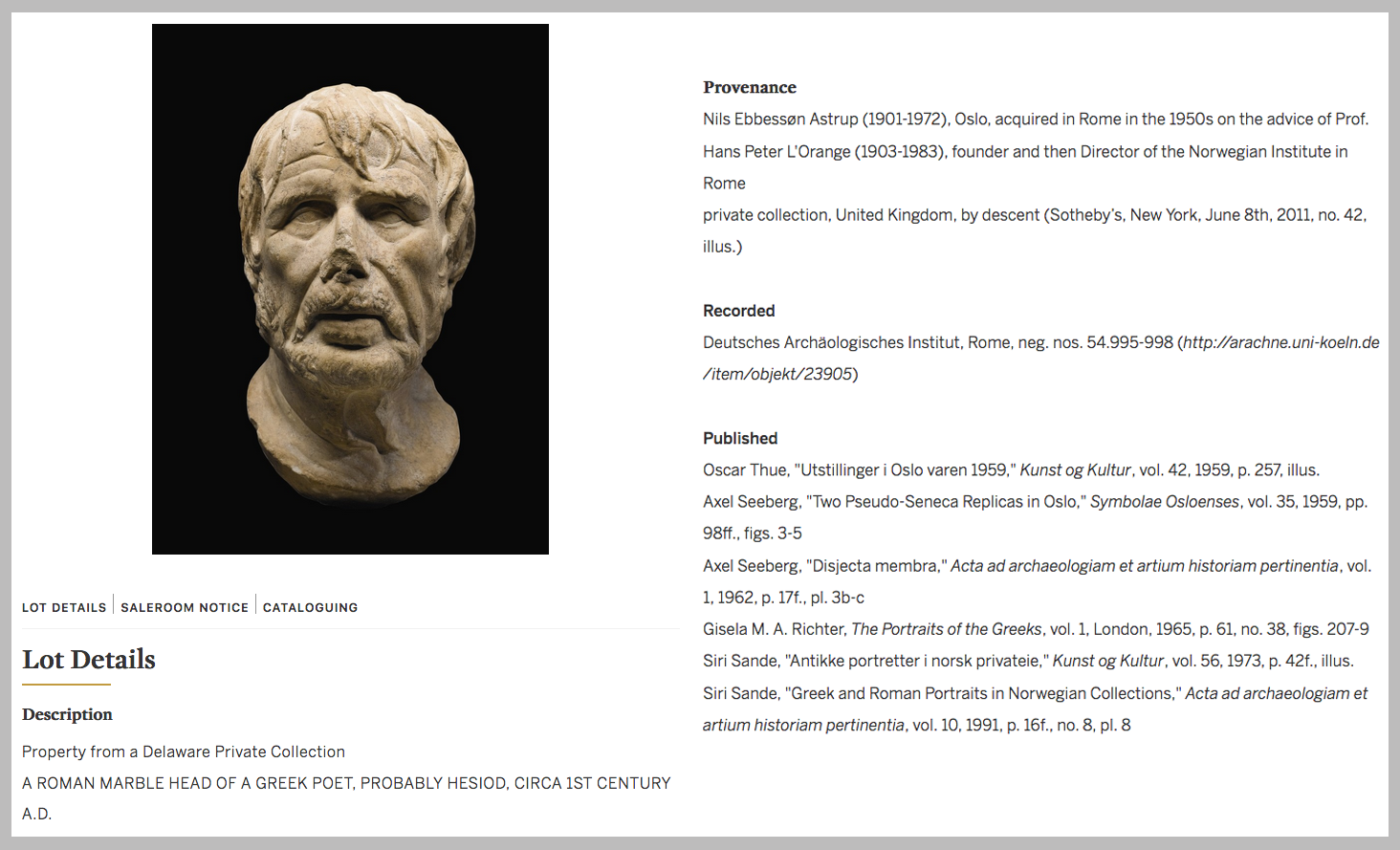The increasing importance of provenance: three lawsuits
Three high profile lawsuits in the early 2000s had a strong impact on how the market for antiquities has valued provenance (the record of ownership of a work of art or an antique). The first case concerned the prosecution of New York antiquities dealer Frederick Schultz, who had been trafficking antiquities out of Egypt camouflaged as cheap souvenirs. The second one concerned the prosecution by the Italian federal government of Giacomo Medici, who supplied the world’s most important museums with classical antiquities. The third one involved legal action against one of his regular clients — then J. Paul Getty museum curator Marion True — for purchasing material she knew was illegally excavated from dubious dealers (including Giacomo Medici). The combined effect of these three cases was to force collectors and sellers active in the antiquities market to reevaluate the importance of provenance.
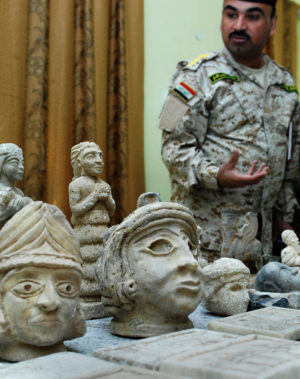
Iraqi Col. Ali Sabah, commander of the Basra Emergency Battalion, displays ancient artifacts Iraqi Security Forces discovered Dec. 16, 2008, during two raids in northern Basra
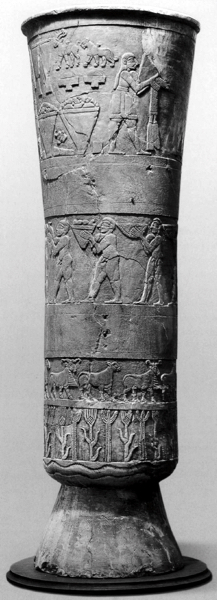
Warka (Uruk) Vase, Uruk, Late Uruk period, c. 3500-3000 B.C.E., 105 cm high (National Museum of Iraq)
1970 UNESCO Convention
Even though the international community had sent a strong signal condemning the illicit trade in antiquities with the passing of the 1970 UNESCO Convention, this measure never truly impacted the market, because its principles could only be invoked by local courts if they were ratified into the national law of individual member states. For instance, the United States passed legislation covering the substance of the 1970 Convention with the passing of the Cultural Property Implementation Act of 1983, which enabled the negotiation of bilateral agreements with other UNESCO member states restricting the importation of undocumented antiquities coming from their territories. Currently, bilateral agreements with 23 countries are in place, including Italy (2001), Greece (2011), Egypt (2016), Syria (2016) and Iraq (2004).
The graph below, which tracks the mention of “looted antiquities” or synonyms in The New York Times and The Guardian, show that it took several decades for the 1970 UNESCO Convention and illegal trade in antiquities to attract public notice. The first substantial spike coincided with a major political event: the 2003 Iraq invasion, when the U.S. army was criticized for the lack of training in the protection of cultural heritage. It was this lack of training (among other things), that ultimately enabled the looting of Iraqi archeological sites as well as the museum in Baghdad — causing the dispersion of thousands of objects, including widely studied works of cultural heritage such as the Sumerian Warka Vase.
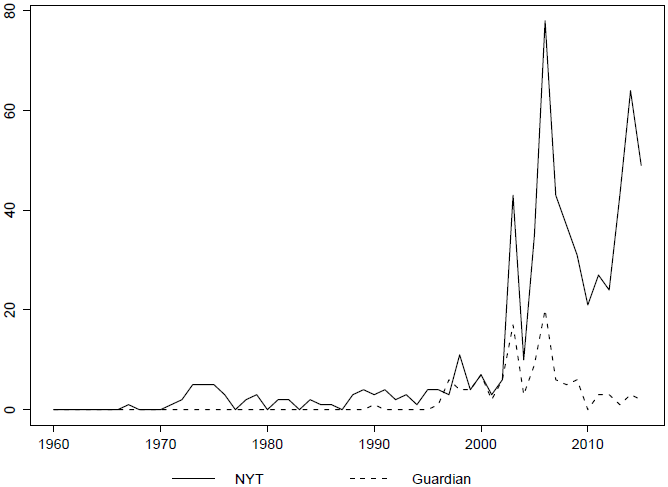
Graph I: Search result for “looted antiquities” (and synonyms) in the New York Times and the Guardian (1990-2015). From Silvia Beltrametti and James V. Marrone, “Market Responses to Court Rulings: Evidence from Antiquities Auctions,” The Journal of Law and Economics, vol. 59, no. 4 (November 2016), pp. 913-944.
1. Frederick Schutz and the trafficking of Egyptian cultural property
2003 was the year Frederick Schultz, a New York gallery owner specializing in Egyptian antiquities, was prosecuted for the illicit trafficking of Egyptian cultural property. The courts held that a patrimony law passed in 1983 made Egypt the legal owner of antiquities found on its territory, and that by smuggling and reselling antiquities looted from its ground, Schultz was guilty of trading stolen property.
In many ways the court utilized the Schultz case to showcase that (notwithstanding the lack of preparedness with regards to the looting in Iraq), the U.S. took crimes against cultural heritage seriously — and the final sentence for Schultz was stiff: 33 months in prison and a $50,000 fine.
2. Giacomo Medici and the trafficking of classical antiquities
Meanwhile in Rome, prosecutors were gathering evidence to incriminate Giacomo Medici, a dealer based in Geneva who supplied most of the world’s high-profile museums with classical antiquities coming from Italy. In 2004 the Tribunal in Rome convicted Medici to a 10-year imprisonment term and a EUR 10,0000,000 fine for trafficking thousands of looted objects.
3. Marion True and J. Paul Getty Museum
Evidence that surfaced during the investigation (which included Polaroid photographs outlining Medici’s possessions as well as precise ledgers describing their current locations and buyers), showed that one of his regular clients was Marion True, antiquities curator at the J. Paul Getty Museum in Los Angeles. True had purchased 42 pieces from him over the years, likely knowing that they were the product of illegal digs (or choosing to turn a blind eye towards that pssibility). She too, was prosecuted by the Italian government for conspiring to launder stolen antiquities, and even though the case was eventually abandoned, the evidence against her was significant enough that she lost her job. The Getty returned the pieces she had purchased from Medici and other dubious dealers, to Italy — including the statue of an Aphrodite that True had purchased for eighteen million dollars.
Overall these cases were incredibly important because they conveyed credible commitments that sanctions for trafficking looted antiquities would be enforced and signaled to market participants that they needed to pay attention to provenance. But what does that mean in practice? What type of provenance information makes an object legitimate within the antiquities market?
Auction houses and provenance considerations
Let’s look at this question from two angles: buyers and sellers. The evolution of the regulation in place at major auction houses is helpful in understanding the steps that such entities have put into place to avoid the risk of reputational harm associated with trading looted antiquities.
Provenance considerations connected to the trade of classical material started surfacing in 1998 (note the small spike in graph 1) when journalist Peter Watson exposed internal practices at Sotheby’s designed to back the trade of illegally exported antiquities. The auction house closed down its London branch as a result, and decided to only trade antiquities from its New York office. However, when the U.S. entered into a bilateral agreement with Italy in 2001, the due diligence efforts in connection with provenance documentation increased. Consignors who were hoping to sell antiquities through Sotheby’s had to present documentation showing that the object was located outside its probable country of origin (Italy in the case of most classical pieces) before the bilateral agreement entered into force, in 2001. Later, as the market became aware of the Medici archive as well as documentation about looted pieces coming from the archives of other dealers (including Robert Symes and Gianfranco Becchina), auction houses had to take further measures to counter threats of illicit trade — because, if looted material previously recorded in one of those archives filtered through such checks, auction houses would get a call asking for the lot to be withdrawn (sometimes they still do).
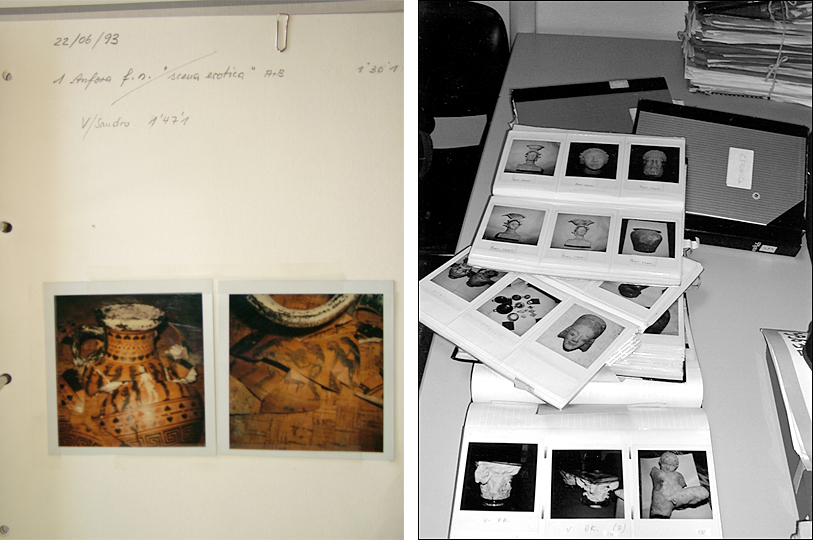
Left: Image of an ancient Greek Amphora from the Becchina Archive (Courtesy of Dr. Christos Tsirogiannis); right: Polaroids seized in Giacomo Medici’s warehouse
In 2006 Sotheby’s hired Jane Levine, former FBI art crime expert, to run its compliance division and pay specific attention to issues connected to looting, and since then more stringent verification of provenance is being performed. If a claim is made that a specific piece was bought from a particular dealer, the latter will have to present proof (including receipts and other evidence verifying the truthfulness of such statements). As a result, the patterns of antiquities sold at major auction houses have undergone significant changes in the past 20 years, which are noticeable from the graphs below: fewer pieces with better provenance are being sold.
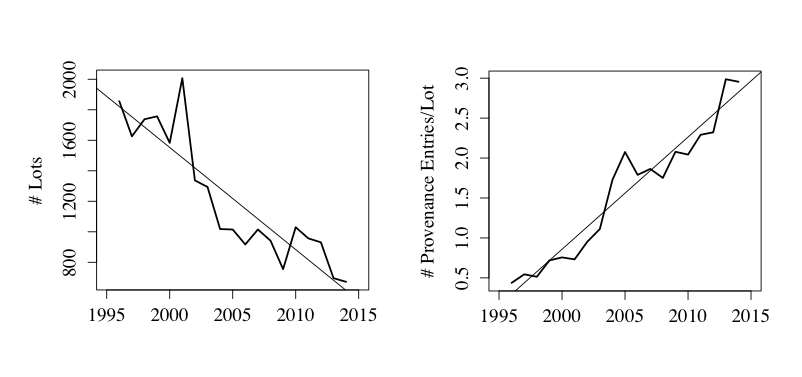
Left: showing the number of antiquities sold by Sotheby’s and Christie’s (combined) between 1995 and 2015; right: showing the amount of provenance information per lot between 1995 and 2015. Both from Silvia Beltrametti and James V. Marrone, “Market Responses to Court Rulings: Evidence from Antiquities Auctions,” The Journal of Law and Economics 59, no. 4 (November 2016), pp. 913–944.
Buyers at these same auctions are valuing provenance more than they have ever done. In the Schultz case, the court made it clear that in order to be legally traded, an ancient object originally from Egypt had to have a verifiable provenance record showing that the piece had either been outside of Egypt since before 1983 or that it comes with an export permit, and indeed since 2003 the pieces sold at auction that meet that criteria have more than doubled. In connection with classical antiquities the situation is trickier because the classical world is spread across many territories that overlap with a number of modern nation states, all of which have different laws. Greece and Italy have had patrimony laws in place condemning the theft of their cultural heritage since the 19th century.
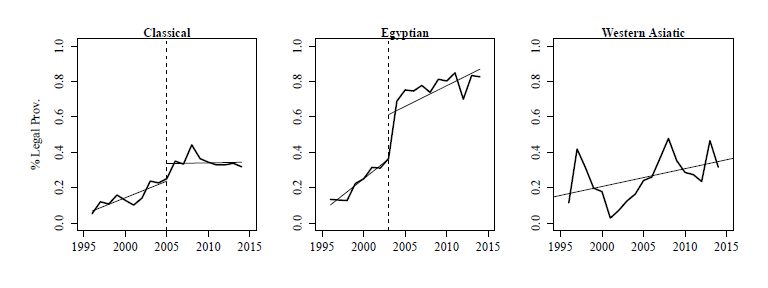
Showing the percentage of antiquities sold through Sotheby’s and Christie’s that meet the 1970 threshold and the 1983 threshold. From Silvia Beltrametti and James V. Marrone, “Market Responses to Court Rulings: Evidence from Antiquities Auctions,” The Journal of Law and Economics 59, no. 4 (November 2016), pp. 913–944.
Because of the difficulty with allocating an ancient object to a modern country of origin, and verifying whether its provenance history meets thresholds set out by specific laws, institutional collectors such as The Metropolitan Museum of Art and the J. Paul Getty Museum have passed internal guidelines stating that they will generally not acquire an object in the absence of information proving that the piece was outside its country of origin before 1970 (or legally exported from its country of modern discovery after 1970). And again we can see a trend from the above graph verifying that since the Medici prosecution in 2005, more classical antiquities meeting the 1970 threshold are being sold. Table I further corroborates that those items sell for higher prices. The patterns are the same for Western Asiatic antiquities, a category used by auction houses to refer to ancient material coming from the Near East, even though there are no distinguishable linear trends.

Table I: Breaking down pricing for objects meeting the 1970 and 1983 thresholds respectively. From Silvia Beltrametti and James V. Marrone, “Market Responses to Court Rulings: Evidence from Antiquities Auctions,” The Journal of Law and Economics 59, no. 4 (November 2016), pp. 913–944.
Where do we go from here?
Overall, provenance considerations have become very important in the antiquities context, and it is now unthinkable to purchase a piece of ancient art without performing the necessary due diligence. Museums have to abide by strict regulations and even private collectors are best advised to do so, if they are hoping to resell their collections down the line. Well-provenanced (that is, works that have a long history of ownership), high-quality pieces are few and far between, but they can still be found. Last December Sotheby’s sold a Roman marble head that had been in a private collection in Norway since the 1950s for about $1.5 million. Another convenient avenue for cultural institutions to continue showing and studying antiquities is to enter into collaborations with museums in source countries and negotiate long-term loans in exchange for support with scholarship, conservation, and excavation efforts.


